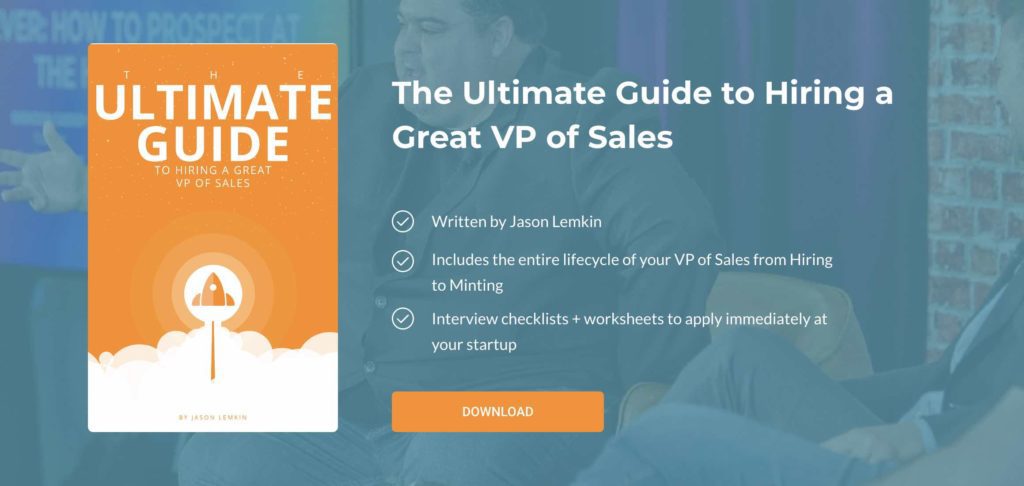I’m not ashamed to admit that when I set up our first SaaS sales comp plan, I had no idea what I was doing. In my first start-up, yes, I sold to the enterprise. I sold $6m our first year (man, that sounds good looking back on it). But I did all the sales myself, and stupidly, had no sales comp plan at all. 😉
Then at Adobe Sign / EchoSign, I had some good — and painful — learnings. At first, I just made up a plan. Then, as we first scaled up a sales team, we ended up literally copying Salesforce’s comp plan.
My uber-learnings from that are that BigCo sales comps plans are great tools — once you are reasonably post-Scale. Once you are at $20 or $30m ARR or larger, or maybe, once you have 40-50 reps or more, and are adding another 40-50 or more a year … a Typical Bigger Company sales comp plan works well. It’s tested and proven.
But it didn’t work for me, for us. Why?
SaaS Enterprise Sales Compensation Plan
Well, a typical BigCo Sales Comp Plan for an experienced inside sales rep works this way:
- Guaranteed, Competitive Base Salary. Walk into work, you make $50-$100k, or whatever the guaranteed base is.
- Commission that is a Relatively Low % of the Deal. Often, 8-11% of the first-year ACV, sometimes less
- Relatively High Quota. You don’t make a lot on each deal, and with a high quota, it’s a big nut to hit. This can be hard in the early, learning days of a SaaS start-up.
- Almost Complete Hand-off of Customers to “Others”: Customer Success, Account Manager, etc. the Moment After Sale. Very little post-sale involvement with customer. Most upsell handled by others in the org.
- Lots of Accelerators and Decelerators. Lots of little programs to incentivize desired behavior. Can lead to quarter stuffing, quarter stretching, multi-year deals over quarterly ones, etc., etc.
- Sense That Sales Reps Shouldn’t Make Too Much or Something is Wrong, and/or the Bar is Too Low. If they make too much, the quota was too low. Or the comp plan was too generous. If someone is doing too well … raise the bar. Because …
- In General, Sales is Seen as Cost-Center at Very Big Companies. An important one, but ultimately a cost of doing sales and business. Which is certainly true once you get into the Fortune 500.
This sounded OK — not great, but OK — to me. But it turned out to be a dismal failure for us.

Here were all the problems a Traditional Sales Comp plan created:
- Incentives for Mediocre to Stay. If you’re mediocre and make a decent base, you just stay. And if the quota is too hard to hit, and you don’t believe you can hit it … you don’t really try …
- Not Customer-Centric Enough. All I cared about was the customers. The problem is if you only pay a rep 8-10% of a deal, and then the rep goes away the second the contact is EchoSigned … it’s too much of a sales factory. A boiler room. Yuck. How can you spend any time on a $5,000 ACV customer if you only make $500? And, seriously, why would you even follow up with a smaller potential lead unless you were 90%+ sure it would close in 1-2 calls? A full demo? Sorry, I don’t have time, ma’am.
- Good Ones Didn’t Make Enough. I saw the mediocre ones making too much — but the good ones didn’t make enough. I wanted them driving M6 Convertibles and shiny new S5s if they were killing it. The top 10-15%.
- Way Too Confusing. Accelerators, decelerators, micro-incentives. I mean, remind me again, why would I do this for another 2%? And why are you adding decelerators that ‘punish’ activity that still adds ARR? I couldn’t understand it. And if I couldn’t get my arms around the plan … how could I champion it?
- Doesn’t Maximize Revenue or Success Per Lead. The real uber-problem in a Traditional BigCo Sales Plan is designed to maximize absolute revenue across a large sales team. Great. But it isn’t designed to maximize all the leads. In the early days, every lead is precious. I wanted every lead followed up on. Every potential customer fawned over. And appreciated. Because especially in the early days — qualified leads are a gift. Don’t squander them.
So what happened? Revenue per lead fell by over 50% with the BigCo sales plan. Ouch. That was our Year of Hell.
Now, a lot of this drop was due to the fact that we lowered the bar when we added this wave of reps. Only 1 — just 1 — met the ultimate bar when we hired our True VP of Sales. So I guess that’s the real story. But the Mismatched Comp Plan made it all the more confusing and created all the wrong incentives.
So what did I do? I stepped back.
I listed out our goals for getting from $1m to $20m+ in ARR
- Make sure reps are paid a fair, market wage. The OTE has to be competitive.
- Make sure the great reps can really make good money Tesla Plaid and M8 convertible money, not fancy watch money.
- Make sure the reps that won’t make it, if we hire any more, cycle out on their own. No incentives for the mediocre to stay.
- Make sure the reps are paid to love all the prospects and customers. To spend the time to make every single customer of >$X,000 in ACV at least a big success period.
- Not break the bank. Overall costs have to actually be equal to less than BigCo comp plan.
- Simplicity. No more comp plans, for now at least, that anyone can’t intuitively understand.
- Maintain positive, long-term, win-win customer relationships — as appropriate. Not every customer should ‘stay’ with a rep. Not every rep should be involved in chasing down invoices. But reps need to do both where it’s best for the customer and company.
- Make sales clearly, unarguably, a profit center. Not a cost center. This would destress my life in 100 ways and clarify a lot of things.
OK, so with that, here’s what I came up with. First, I did an analysis of what inside sales reps at SaaS companies are usually paid. Usually, all-in, they are taking home about 20%+- of the ACV at the end of the day. More sometimes, if you’re well funded, but it’s usually in the 20%-25% range (i.e., reps have to close 4x-5x their On Target Earnings). Often, Base+Bonus is structured 50/50, so it’s 10% or so (+- 2%) as base … and a matching 10% or so (+- 2%) as bonus. And that’s OK, and it’s simple.
But it costs the company almost twice that, typically. Why? The losers suck up a ton of cash. Because they get large base salaries. And they burn a ton of your limited leads. Have too many subpar reps, and your economics are wrecked. And scaling reps, of course, is expensive too.
So I came up with “The Plan”
- Competitive Base Salary — But You Cover it (Including Benefits) Before Any Bonus. At Least Partially. E.g., no commission at all each month/quarter until you clear a hurdle. Whatever your base is each month – $4k, $6k, $10k, whatever … under my plan, you first had to bring in the revenue to cover it before you took any bonus. I.e., no commission at all until you pay off your base salary + benefits. It’s similar to a draw, but not a true draw — your base salary is a salary. (True draws do not create any real incentives to perform.)
- Pay 2x as Much in Commission. You’ll have to figure your own exact model out, but basically, for us, I figured if reps paid their base back first, and the losers then didn’t suck up a lot of cash — I could push the full 20-22% of ACV straight to the rep as commission. And even more, if 80%+ of them all hit their plan. It’s what you’d end up paying in the BigCo plan anyway. So instead of a 10-11% commission, I paid ~20%-25%. But only once you paid back your base. (The exact % may vary for you based on your unit economics). That way, if all the reps hit plan, we’d still only be paying about 20%-25% of each deal in total rep comp. But the individual reps would make a lot more if they all killed it.
- One Accelerator: Cash Up Front. Paying 25% instead of 10-12%, but only once you pay for your base salary, is itself an inherent accelerator. The sky is the limit once you’ve paid your base back. But there was one thing that mattered when I wanted to be cash-flow positive: cash. So I paid more for cash-up-front deals. Less for the rest (this may not matter for you if you don’t do monthly or quarterly options). And I paid a partial-to-full commission on any Year 2 cash, upfront. That cash now was very valuable. T
- Optional: Payment Upon Receipt of Cash, Not Contract E-Signing. Later, once we were past $10m or so, this didn’t matter so much. But in the early days, it was my way of aligning interests. I’ll pay you a lot. If you perform. But only once you take care of business and take care of the company. And get the cash in the door. Reps hate this. But if they are going to stay 12+ months … it doesn’t matter. They’ll see that. Especially if the top reps are driving Tesla Paids and M8 convertibles. Do this if it makes a difference in cash flow. Don’t do it if it doesn’t make much of a difference. At SaaStr itself, with our little sales team, we did this for a while, but then stopped once we had enough cash flow. No real need to do it after, but everyone will understand if you push for it in the early days.

This new sales comp plan, it worked great for me:
- There were automatic accelerators.
- The sky was the limit for the A+ reps.
- There was no need to “ratchet up” the plan.
- It rewarded the hungry.
We still had quotas, of course. Our initial annual ACV quotas varied from $380k or so to about $550k, and we continued to refine this over time and drive them up as we got better at sales. Today, perhaps I’d make them a bit higher. We have better systems and tools today, and the velocity is even faster. But quotas just weren’t as important, because the plan created the right incentives to hit these numbers and exceed them — irrespective of what quotas were set. (Note: this is really an inside sales rep plan. We can talk more about field sales later. But the same basic concepts work there too).
And perhaps most importantly, as a founder / CEO — I knew exactly what I was paying for sales. 25% of ACV, all-in. No more black holes like in the BigCo Plan. I didn’t have to worry about anything, economically, in sales anymore. Ever. And sales quickly, elegantly … became a profit center. Instead of a cost center. That was epic.
My stress re: sales comp and cost of sales flew right out the door.
…
And a bit of a coda. At SaaStr itself today, we’re running this same playbook again. We’re paying folks really well, with automatic accelerators. The big difference is we also pay really well on renewals, which makes sense for us, since it’s a re-sale (this doesn’t make sense for most SaaS companies).
And what happened, the second time around? Well, our average rep now closes over $3m a year. And our top rep has closed $25 million. Yup, that’s right.
I just have to get him to buy the Tesla Plaid or M8 convertible. He can certainly afford it.
Grab the full plan and much more at our FREE eBook Here on Hiring a Great VP of Sales:
note: an updated version of our classic post


